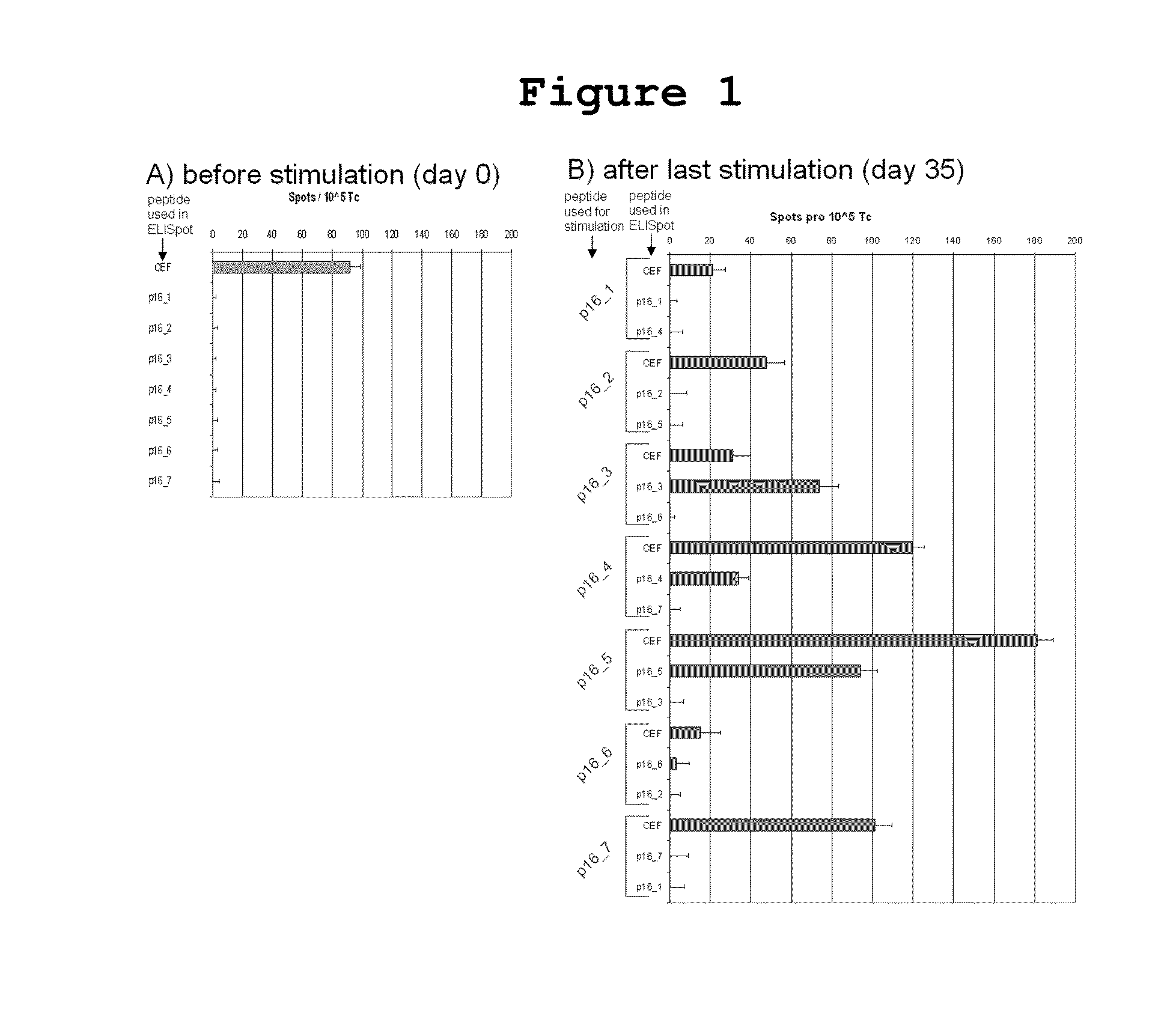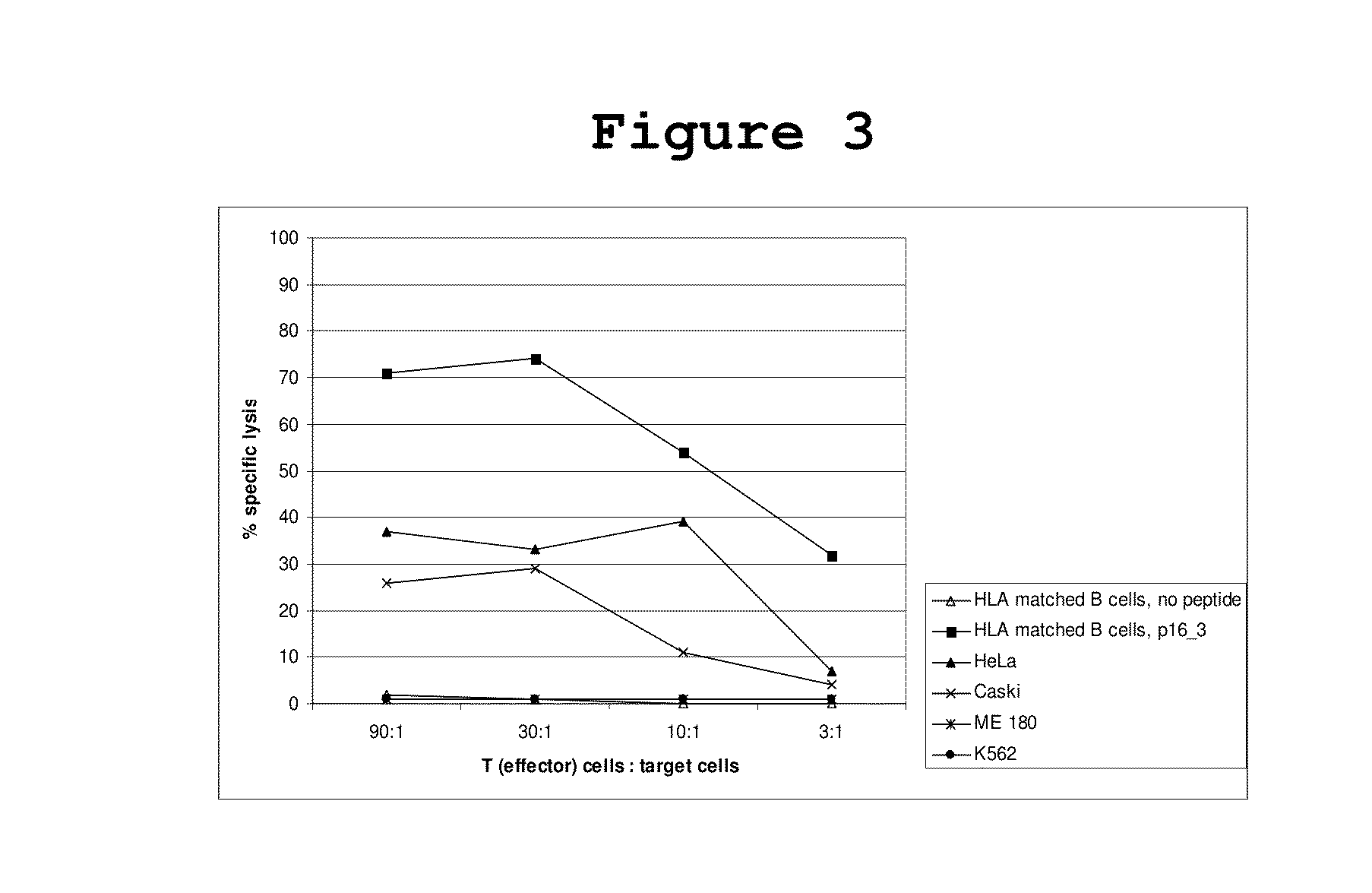P16ink4a derived peptides for prophylaxis and therapy of hpv-associated tumors and other p16ink4a expressing tumors
- Summary
- Abstract
- Description
- Claims
- Application Information
AI Technical Summary
Benefits of technology
Problems solved by technology
Method used
Image
Examples
example 1
T Cell Reactivity Against p16INK4a Peptides in Patients with HPV-Associated Neoplasia
[0038]In order to evaluate whether and to what extent patients with HPV-associated tumors raise T cell responses against the strongly overexpressed p16INK4a, different methods were applied which allow for a detailed characterization of immune responses against the p16INK4a antigen. The finding of spontaneous immune responses against p16INK4a in cervical cancer patients proves the immunogenicity of the antigen in general and the particular p16INK4a fragments and provides the rational for immunizing patients with p16INK4a expressing tumors with the p16INK4a fragments.
[0039]Peripheral blood mononuclear cells (PBMCs) from 13 women with p16INK4a-expressing high grade cervical dysplasia (CIN2 / 3) were incubated with p16INK4a peptides (Table 1) to determine the proliferative capacity of the immune cells by applying a BrdU assay as a global measure for lymphoproliferative potential after challenge with the p...
example 2
In Vitro Priming of Healthy Donor T Cells with p16INK4a Peptides
[0042]Seven long 25-35mer peptides covering the entire p16INK4a amino acid sequence, each with a 7-13 amino acid overlap were tested to define p16INK4a fragments which are able to induce interferon gamma secreting T cells from healthy donors in vitro. (Table 1).
TABLE 1Seven overlapping p16INK4a peptides used in in vitro experimentsNo.peptideamino acid sequence1p16INK4a_1-25MEPAAGSSMEPSADWLATAAARGRV2p16INK4a_18-44TAAARGRVEEVRALLEAGALPNAPNSY3p16INK4a_37-63LPNAPNSYGRRPIQVMMMGSARVAELL4p16INK4a_51-80VMMMGSARVAELLLLHGAEPNCADPATLTR5p16INK4a_73-ADPATLTRPVHDAAREGFLDTLVVLHRAG104ARL6p16INK4a_98-HRAGARLDVRDAWGRLPVDLAEELGHRD128VAR7p16INK4a_123-GHRDVARYLRAAAGGTRGSNHARIDAAE156GPSDIPD
[0043]In order to show that p16INK4a fragments can stimulate healthy donor T cells in vitro to secrete interferon gamma and to identify the most immunogenic p16INK4a derived epitopes, it was investigated whether T cells isolated from peripheral blood of he...
example 3
Lysis of Cervical Cancer Cell Lines by p16INK4a Reactive T Cells
[0049]The ability of activated T cells to lyze p16INK4a expressing cervical cancer cells was tested by chromium release assays using different cervical cancer cell lines as well as HLA matched B cells loaded with p16INK4a peptides as targets. 10×6 target cells (peptide loaded HLA-matched B cells, B cells without peptide) were incubated for 1 hour with 51Cr (100 μCi) and afterwards with different ratios of T cells from one representative cervical cancer patient that reacted against target cells loaded with the peptide p16INK4a—37-63 in ELIspot assays. Specific lysis of target cells by the T cells can be measured by detection of released radioactivity.
[0050]It could be shown that the CD8+ T cells of a cervical cancer patient that reacted against target cells loaded with the peptide p16INK4a—37-63 in ELIspot assays were able to lyse HLA-matched and p16INK4a—37-63-peptide loaded B cells as well as the cervical cancer cell l...
PUM
| Property | Measurement | Unit |
|---|---|---|
| diameter | aaaaa | aaaaa |
| nucleic acid sequence | aaaaa | aaaaa |
| pharmaceutical composition | aaaaa | aaaaa |
Abstract
Description
Claims
Application Information
 Login to View More
Login to View More - R&D
- Intellectual Property
- Life Sciences
- Materials
- Tech Scout
- Unparalleled Data Quality
- Higher Quality Content
- 60% Fewer Hallucinations
Browse by: Latest US Patents, China's latest patents, Technical Efficacy Thesaurus, Application Domain, Technology Topic, Popular Technical Reports.
© 2025 PatSnap. All rights reserved.Legal|Privacy policy|Modern Slavery Act Transparency Statement|Sitemap|About US| Contact US: help@patsnap.com



